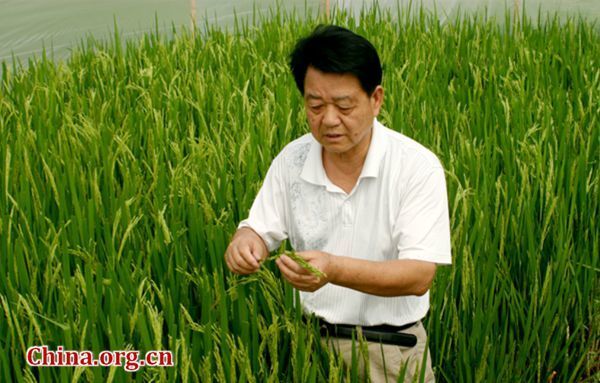A trail blazer of China's hybrid rice research
- By Mi Xingang
 0 Comment(s)
0 Comment(s) Print
Print E-mail China.org.cn, November 21, 2019
E-mail China.org.cn, November 21, 2019

Over more than 40 years, Yan has worked like a migrant bird flying between Hainan and Jiangxi. Recalling the tough circumstances at the experimental field in Hainan in the past, he narrated: "I lived in a thatched room with ravaging rats and mosquitoes and had to deal with typhoons and a tsunami now and then. We had to guard the test field against rats and pigs day and night, watching out for snakes and leeches." Conditions have now greatly improved.
As he worked in the mud neglecting food and sleep, he fell down in a faint one day in 1992. He was diagnosed as suffering from meningioma, a severe disease of the brain; yet, even while undergoing an operation in Beijing, he was still concerned about breeding seeds. Shortly after operation, he returned to the research on new varieties.
In 1995, he acted as the president of the Jiangxi Academy of Agricultural Sciences and he was widely deemed as a selfless leader. In order to attract and retain talents, three apartment buildings were built for intellectuals.
However, he didn't occupy any room, still choosing to live in his small apartment with his family. Just after he retired in 2003, he voluntarily retreated from the welfare apartment and returned to his hometown. "The academy recruited many college graduates, and they needed every single living place," he explained.
After being elected an academician of the Chinese Academy of Engineering in 2007, Yan had a new understanding about his research direction. "During the period when people experienced starvation, high yield was the priority of hybrid rice research. Now, since people's living conditions have been greatly improved and they all have sufficient food, the priority should be the quality or the taste of rice," he stated.
Led by Yan, the Jiangxi Super-rice Research and Development Center was established in 2012. With a team of 22 researchers now, the institute focuses on rice generic resources exploration, new variety breeding, demonstration and promotion, genetics and biology research, scientific cooperation, commercialization of research findings, and so on.
In 2018, the team successfully cloned the Dongxiang wild rice cytoplasmic male-sterile gene and a thesis was published in Plant Journal. The finding is expected to realize promotion in large areas, Yu noted. Right now, Yan and his team are doing research on green super-rice, which possesses features of high yield, multi-resistance and high-quality. It means the rice line should incorporate all advantageous genes.
Yan lays the emphasis on exploration of genetic resources and has collected, preserved and made use of wild rice resources worldwide. He and his team have collected over 1,000 wild rice plants to extract favorable genes and breed new varieties. For instance, they chose wild rice plants as samples as their genes are the stablest.
"The cold-resistant gene has been found," Yan said with gratification. "But we still have a long way to go."






Go to Forum >>0 Comment(s)